SPOILERS FOR GENSHIN IMPACT CHAPTER II, ACT III, “OMNIPRESENCE OVER MORTALS”, AND “IMPERATRIX UMBROSA” AHEAD!
It’s been a while since the Inazuma Archon Quest was neatly wrapped up in Genshin Impact Version 2.1 (a little too neatly and hurriedly, in most players’ opinions), but while the Quest itself hasn’t aged particularly well and is widely considered one of the weakest purely from a storytelling perspective, thematically it’s aged like a fine Osmanthus wine. I firmly believe that everything that took place in Inazuma during the course of that Archon Quest is foreshadowing what will unfold nearer the end of the game’s overarching storyline, when every playable character we’ve met thus far will have to make a choice for themselves, much like the one Raiden Ei had to make at the end of the Archon Quest – a choice between true freedom or the illusion of security.
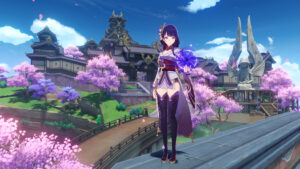
But I’m getting ahead of myself. Before we get into my speculation about where Genshin Impact is headed (and let me be clear about one other thing; it is just speculation for now, because the game’s ending is at least five or six years away), let’s go over what we know for sure – which is how the Inazuma Archon Quest started and ended.
When the game opens, the nation of Inazuma is surrounded by a mile-high barrier of thunderstorms that makes it inaccessible to players who haven’t completed the Mondstadt and Liyue Archon Quests (Given that Inazuma is an island chain in the middle of the ocean, you’d think such drastic measures would be unnecessary, but official data from MiHoYo shows that in February 2022 alone exactly 45,961 players tried to sneak into Inazuma, over half of whom drowned or were struck by lightning and died, so I guess you can’t ever be too careful). This barrier was erected by the Raiden Shogun, a computer in the body of a puppet fashioned in the image of Raiden Ei, the true Electro Archon of Inazuma who had been holed up in a dream-space for almost five-hundred years meditating on the concept of Eternity (every Archon has a lofty Ideal, which they try to impose on the citizens of their respective nations with varying degrees of success).
Raiden Ei had made the difficult choice to leave her people in the hands of a literal puppet at a time when she was still reeling from the loss of her sister and most of her close friends in a war between the gods of Celestia and the technologically-advanced civilization of Khaenri’ah (the latter of whom were wiped off the face of the earth in what became known as the Cataclysm). She saw Eternity – or, as she understood it, permanent stasis – as the means by which she could not only delay her own inevitable decay and thus preserve the memory of her loved ones long after the rest of the world forgot them, but also protect Inazuma; for if her people never progressed, and their ambitions never exceeded their mortal limitations, the gods of Celestia would let them be.
For Inazuma to remain eternal, however, required a leader who would never change, one whose judgement could never be swayed either by counsel or degradation of the mind and who would never hesitate to eliminate any perceived threat to Eternity, regardless of what form that threat might take – a computer, essentially. Raiden Ei’s first attempt at computer programming resulted in a homicidal clone of hers stalking the Inazuman countryside for centuries, but with a few tweaks and adjustments she designed the Raiden Shogun to rule Inazuma in accordance with a strict set of rules she left behind, dictating in excessive detail exactly which aspects of Inazuman culture and civilization were insignificant enough that they could be allowed to change over time, and which must stay the same so that Inazuma would always remain Inazuma.
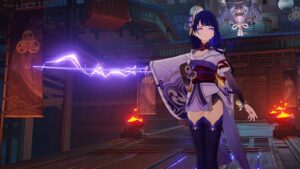
It wasn’t long before foreign dignitaries like the Fatui Harbingers and corrupt individuals in the Shogun’s own court began pulling the puppet’s strings and manipulating her relatively straightforward programming to further their own agendas, with the Fatui being the first to suggest that the Shogun should close Inazuma’s borders to outsiders (the irony!) and forbid Inazuman citizens from traveling abroad. Ei was aware of some of this from her dream-state, but naively believed that the Raiden Shogun was still in control of the situation.
About a year before Genshin Impact‘s story opens, the Fatui successfully convinced the Raiden Shogun to take the same drastic measures towards Vision-wielders in her own nation. Visions, for context, are gemstones that fall from the heavens into the hands of ordinary people, allowing them to manipulate one of the seven elements – almost every playable character in Genshin Impact besides the protagonist has one, although the Archons and a handful of other characters don’t actually need theirs to manipulate the elements. To receive a Vision is to be marked by the gods for greatness, and it’s generally believed that they’re given to people with unusually strong ambitions.
It’s not hard to understand why the Raiden Shogun was deceived into believing that Visions were antithetical to Eternity. Vision-wielders are supposed to change the world, for better or worse (or at least, that’s what they believe), but in Inazuma every substantial change was immediately reversed by the Shogun and its instigators punished with death. Rather than kill every Vision-wielder in Inazuma in one fell swoop, the Raiden Shogun merely ordered them all to relinquish their Visions into the hands of the Shogunate so they could be inlaid upon the Statue of the Omnipresent God outside the Shogun’s palace…although why, exactly, is still unclear and there are several theories regarding the identity of the Statue’s model, who resembles neither Raiden Ei nor her deceased sister.
This “Vision-Hunt Decree” led to a bloody civil war in Inazuma when the inhabitants of Watatsumi Island rose up in resistance to the authoritarian Shogun’s forces with a little help from certain high-ranking members of the Yashiro Commission and Shuumatsuban. The player arrives in Inazuma right at this crucial moment in the nation’s history, and after roughly ten minutes of training and fighting alongside the Resistance, we find ourselves standing before the throne of the Raiden Shogun. The nefarious Fatui plot to manipulate the Shogun’s programming is exposed, and the Shogun single-handedly puts an end to every player’s dream of a playable La Signora by cutting the Fatui Harbinger up into very small pieces.
The important bit comes a little later, after we defeat the Shogun, break into Raiden Ei’s dream-space, and convince her that what she’s doing is hurting the people of Inazuma – not just Vision-wielders, but everyone. She agrees to abolish the Vision-Hunt Decree right away, but it takes her until her second Story Quest to accept that her understanding of Eternity was flawed from the very beginning, that nothing in the world can be made to last forever, and that only by embracing change and adapting in response can Inazuma continue into the future.
And that right there is the same lesson that I think every Vision-wielder in the game will have to learn for themselves nearer the end of Genshin Impact’s story. I apologize if it took me a while to make my point, but I’m here now, and let me explain why I feel this way.
What we know for certain about Visions is what I’ve already told you, that they fall from the heavens and can help level the playing field for ordinary folks by allowing them to use one of the seven Elements in combat and in their daily lives, which is pretty useful for accomplishing heroic feats even if it won’t necessarily buy you a house or put food on the table (see: Mona Megistus). What we don’t know is where Visions actually come from, who or what higher power is in charge of distributing them, what purpose the Visions serve in the long-run besides making Genshin Impact’s combat system more engaging, whether there’s any logic to who gets one and who doesn’t…essentially, we know nothing, and everything we think we know is based on what random characters in-game think they know, which itself isn’t a whole lot.
That hasn’t stopped fans from speculating, and there’s a bunch of really compelling theories on all of these topics out there if you’re interested. I don’t have anything particularly revolutionary to say regarding the potential origins of Visions – I’ve long believed that they come from Celestia, and that one or more of the gods up there on that floating island in the sky (assuming that’s really Celestia, and not an elaborate decoy) are in charge of making Visions and then sprinkling them over Teyvat, and my own theories use that idea as a baseline, so if I’m wrong about that, then I’m wrong about everything else too.
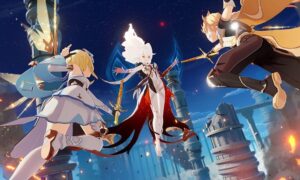
But I don’t think I’m wrong. Raiden Ei explicitly tells us that Visions aren’t handed out by the Archons, as was once believed to be the case, which leaves Celestia as the only entity (or group of entities) we currently know of that (a) apparently dwells in the skies above Teyvat, (b) probably has the means to create and distribute Visions, and (c) definitely likes to throw things at the earth; mostly these creepy glowing pillars called “Nails” that they’ve historically used to impale entire cities whenever they’re displeased by something, but who’s to say that Visions couldn’t do damage on a similar scale, not just to one city but to every town where Vision-wielders live?
So why would Celestia, notoriously ambivalent about humans in general and all-too-eager to eradicate anyone who oversteps the boundaries between mortal and deity, reward the most ambitious and strong-willed humans on the planet with increased power? Well, I want you to think long and hard about what every character has done with their Vision, not in regular combat but in the story itself and in the lore, and then I want to know the results of your findings because, as far as I’m aware, the only time someone’s Vision has actually allowed them to do something that they might not otherwise have accomplished was when Kazuha used his dead friend’s Vision to save us from the Raiden Shogun during the Inazuma Archon Quest – and the fact that it wasn’t even his Vision is telling.
Simply put, I don’t think Visions are a reward so much as they are an incentive, provided by the gods in Celestia, to just keep doing what you’re doing until you eventually die in battle, fall off a cliff, or run out of stamina while swimming to Inazuma and drown. They haven’t, to my knowledge, helped anyone do…anything, really. Instead, they keep their wearers locked into the roles that Celestia deems safe or inconsequential, roles from which it’s hard to break free because one of the caveats of owning a Vision is that if your ambition changes for any reason, your Vision will stop working…and most people don’t want that to happen, so they keep playing the part that Celestia chose for them their entire lives.
But as we’ve learned from NPCs like Zhiqiong in the Chasm, you don’t need a Vision to be ambitious. Of course, because Zhiqiong became interested in learning the truth of the world and ventured deep into the Abyss searching for answers, it makes sense why Celestia wouldn’t reward her with a Vision (although by the next time we see her, maybe she’ll have been granted one in the hopes that it will get her to stop poking around in places she shouldn’t). But still, it just goes to show that people can accomplish great deeds on their own without having any access to the Elements – and when you think about it, there are even a couple of playable characters who can already deal massive amounts of physical damage without using Elemental reactions.
And on top of that, let’s not forget that in Kamisato Ayaka’s recent story teaser depicting how she got her Cryo Vision during a duel with her brother (supposedly when her desire to help her family was at its strongest), she starts using Elemental-infused attacks shortly before the Vision appears on her person…and maybe, just maybe, that means every Vision-wielder in the game already has the ability to use the Elements in much the same way that the protagonist does, even without a Vision. Heck, maybe everyone in Teyvat has that ability, they just don’t know it yet.
Now, it might be harder to learn than to simply rely on your Vision to do all the work for you, but a major theme throughout Genshin Impact is that humans need to start relying on themselves instead of their gods, because gods are fickle, they’re unreliable, they’re emotionally unavailable, they don’t understand what’s best for humans and they can’t make good choices for humans. I mean, there’s a reason why every Archon Quest in the game thus far follows a similar formula – we come in, we have a heart-to-heart with an Archon, and we convince them to either step down or at the very least take a step back from ruling their respective regions so that their citizens can flourish and reach their true potential.
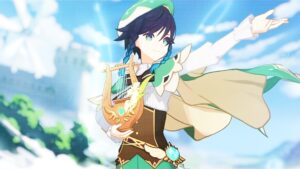
Venti, the Anemo Archon of Freedom who once ruled over Mondstadt, made the choice to put all of his power into the hands of his people without any assistance from the protagonist, a long time before the story opens. Zhongli, the Geo Archon of Contracts, also got there pretty quickly – the hard part was helping him safely abdicate his throne without causing turmoil in Liyue and ensuring that humans and adepti would be able to work together to combat future threats without Zhongli holding them together. Raiden Ei, the Electro Archon of Eternity, is the first Archon we’ve met who needed to witness firsthand just how much pain and suffering she had already caused and how much more she would cause unless she changed and allowed Inazuma to change with her.
Ironically, this entailed letting people keep their Visions – the very thing I think every Vision-wielder will have to give up willingly near the end of Genshin Impact‘s story when the total reverse of this situation plays out, assuming they can embrace what will surely be a radical change for them and wouldn’t rather remain tethered to Celestia by whichever one dream or ambition of theirs allows them to feel special. I believe some will make the choice without a moment’s hesitation; some will first need to know that they can survive without their Visions; and some will need to rethink their entire outlook on the world.
I briefly toyed with the idea that every Archon’s willingness to relinquish their own power foreshadows how the characters of their same Elemental type will react to being asked to relinquish their Visions, but like most theories that hinge on nonexistent correlations between characters of a certain Element, I just couldn’t get it to work. By that reasoning, Keqing, as an Electro character, should be as resistant as Raiden Ei, but she’s canonically “a skeptic without equal when it comes to the value of Visions”, having unsuccessfully attempted to discard and destroy her Vision on numerous occasions.
Perhaps this entire theory is a stretch, but I hope that my reasoning is at least somewhat sound. I felt comfortable putting this theory out in the world because I know I’m not the first person to be suspicious of either Visions or Celestia (in-game, everyone seems to trust the gods unreservedly, but we know better because we’ve been to Enkanomiya and read Before Sun And Moon), but I haven’t seen anyone speculate that the Archon Quests are foreshadowing something and I think there’s a case to be made for why it’s humans parting with their Visions and finally stepping into their own power and embracing the divinity that already lives within them (ooh, I snuck a little bit of Gnosticism in there at the end just to get your interest piqued for my next post on the subject, I feel so clever).
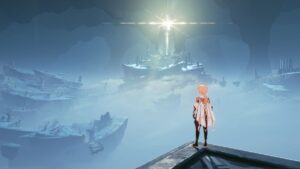
No, but seriously, we need to have a talk about how in Genshin Impact, all humans are divine – not just playable characters, but also (and perhaps especially) the regular NPCs we interact with every day. As I said, that’s another post for another time. Right now, I want to let you ruminate on what I’ve said and expand on it if you think I’m onto something here. I’m still new to theorizing about Genshin Impact‘s future, so if I’ve misinterpreted anything or left out any crucial information, feel free to remind me, and don’t forget to share your own thoughts, theories, and opinions, in the comments below!